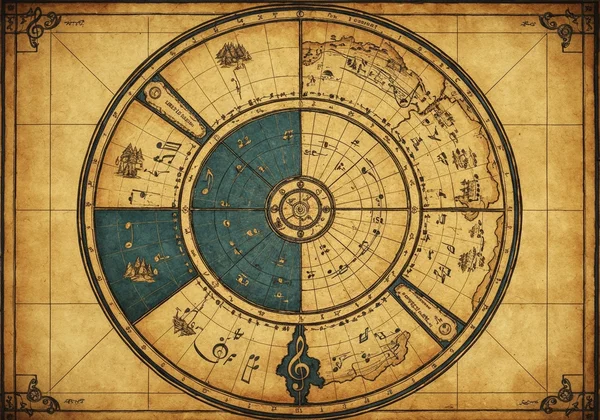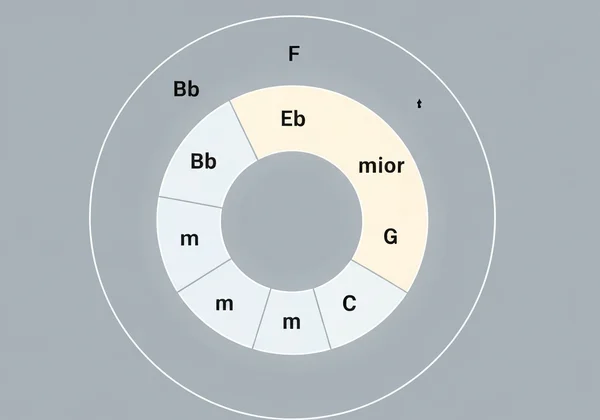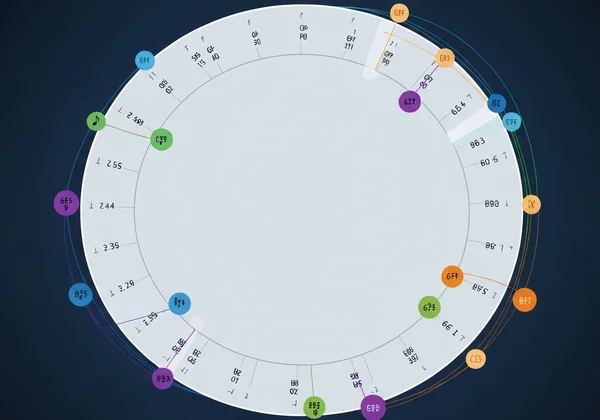Bohemian Rhapsody: Circle of Fifths Music Theory Analysis
Is there any song more iconic, more sprawling, more wonderfully chaotic than Queen's "Bohemian Rhapsody"? For decades, musicians and fans alike have marveled at its genius. It shifts from a soulful ballad to a full-blown opera, then crashes into hard rock before a final, haunting piano outro. But how did Queen stitch these seemingly disparate parts into a coherent masterpiece? The answer lies in a foundational music theory concept: the circle of fifths. What is the circle of fifths used for in a composition this complex? It’s the secret map that charts the song's wild harmonic journey.

This article will break down the musical magic of "Bohemian Rhapsody" section by section. We'll show you how Freddie Mercury and the band used key changes and chord progressions to build emotion and tell a story. And the best part? You can follow along and see these concepts come to life with the interactive music tool on our homepage. Get ready to see this epic song in a whole new light.
Decoding Bohemian Rhapsody's Chord Progressions and Structure
Before a song can take you on a journey, it needs to establish a home base. "Bohemian Rhapsody" is a masterclass in setting up a harmonic landscape and then brilliantly departing from it. The opening sections use the circle of fifths to create a foundation of emotional stability, making the later chaotic shifts even more impactful.
The Ballad Section: Stable Key Signatures and Emotional Setup
The song opens in the key of Bb major. If you look at Bb major on an interactive circle of fifths, you'll see its closest "neighbors" are its dominant chord (F major) and subdominant chord (Eb major). You'll also see its relative minor, G minor. Unsurprisingly, the opening verses are built almost exclusively from these chords: Bb, Gm, Cm, and F. This creates a strong, stable, and familiar sound.
This use of closely related chords is deliberate. It grounds the listener and establishes the song's initial emotional tone—a sense of melancholic reflection. The chords feel like they belong together because, on the circle, they are right next to each other. This is the calm before the storm, a musical foundation built on the strongest relationships within a key. You can explore these chords yourself and hear how they naturally flow into one another.

Pre-Opera Build-Up: Foreshadowing with Chord Progressions
As the ballad section transitions, the harmony begins to stretch. Queen introduces chords that aren't strictly in the key of Bb major, creating tension and a sense of unease. This is where a songwriter's genius truly shines. They use chords that act as pivots, hinting at new keys without fully committing to them yet.
For example, the use of an A major chord before the opera section is a powerful choice. A major is the dominant of D major, a key far away from our starting point of Bb. This single chord acts as a harmonic cliffhanger, a sign that we are about to leap into a completely different musical world. By understanding the circle of fifths, you can see these moments not as random, but as calculated steps designed to prepare the listener for the dramatic shift ahead.
Queen's Masterclass: Bohemian Rhapsody's Song Key Changes Explained
The true heart of "Bohemian Rhapsody's" legend is its audacious opera section, a whirlwind of key changes that would terrify most songwriters. Yet, Queen navigates these treacherous waters with incredible skill. The circle of fifths isn't just a tool for staying in one key; it's also the ultimate guide for changing keys in a way that is both shocking and musically satisfying.
The Opera Section: Rapid Modulations on the Circle of Fifths
"I see a little silhouetto of a man..." This is where the song takes a wild turn. We jump from A major into a new tonal center, and then another, and another. The opera section modulates rapidly through several keys, including A major, Eb major, and C minor. On the surface, these keys seem to have little in common.
However, when you visualize the key changes on the circle, you can see the method in the madness. Queen often uses a chord from the old key that also belongs to the new key (a "pivot chord") or moves through dominant relationships to land in a new tonal center. This section is a high-speed tour around the entire circle, showcasing how even distant keys can be connected. It's this masterful navigation of harmonic space that gives the opera its thrilling, rollercoaster-like quality.

The Hard Rock Outro: Reaffirming the Core Tonality
After the operatic chaos, the song needs to find its footing again. The iconic head-banging rock section slams into the key of Eb major. Why Eb? It's the subdominant of our original key, Bb major. This is a powerful, affirmative move. On the circle of fifths, moving from a key to its subdominant (counter-clockwise) feels like a "plagal cadence," often associated with the "Amen" in hymns. It has a sense of finality and strength.
This section grounds the listener after the disorienting opera. It brings the energy to a peak while steering the song's harmony back toward its home territory. The journey was wild and unpredictable, but the circle of fifths provided the invisible rails that kept the entire structure from flying apart. By the time the song ends, it has completed a full emotional and harmonic arc, a journey you can trace step-by-step with a good Circle of Fifths chart.
Advanced Music Theory Analysis: Beyond Diatonic Harmony
While much of "Bohemian Rhapsody" can be understood through standard key relationships, part of its unique flavor comes from Queen's willingness to break the rules. They frequently use chords from outside the established key to add color and emotional depth, a technique that advanced songwriters love.
Identifying Borrowed Chords and Chromaticism
Throughout the song, you'll find examples of "borrowed chords." These are chords taken from the parallel minor key. For instance, in a major key, you might suddenly hear a minor iv chord. This adds a touch of darkness and sophistication. In "Bohemian Rhapsody," these moments of chromaticism—using notes outside the key's scale—are what give the melody and harmony their distinct, unforgettable character.
The circle of fifths is essential for identifying these moments. When a chord appears that doesn't fit the key's diatonic pattern, the circle helps you see where it might have come from. By showing the relationship between major and relative minor keys, it provides a framework for understanding even the most complex harmonic choices. It transforms what might seem like a "wrong" note into a moment of intentional genius. You can explore music theory like this on our interactive platform.

Your Journey Through Bohemian Rhapsody's Musical Map
"Bohemian Rhapsody" is more than just a song; it's a testament to the power of musical storytelling. Its emotional weight is carried by a sophisticated harmonic structure that can feel intimidating to unpack. However, with the circle of fifths as your guide, the complexity unravels into a clear and logical progression.
From the stable ballad to the chaotic opera and the triumphant rock section, every chord and key change serves a purpose. We invite you to continue this exploration. Pull up the free interactive tool on our homepage and trace the song's path for yourself. Click on Bb major, then jump to A major, then to Eb. See the relationships, hear the chords, and connect the theory to the sound. Your journey into understanding music theory has just begun.
Frequently Asked Questions About Bohemian Rhapsody's Music Theory
How to find the key of a song using the Circle of Fifths?
To find a song's key, first, look at the key signature (the sharps or flats at the beginning of the sheet music). The circle of fifths directly maps each number of sharps or flats to a specific major and relative minor key. For example, three flats correspond to Eb major or C minor. You can confirm the key by looking at the song's first and last chords, which are often the tonic (the "home" chord). Our online circle tool makes this process instant.
What is the Circle of Fifths used for in complex compositions like "Bohemian Rhapsody"?
In complex pieces, the circle of fifths is used as a master plan for harmony. It helps composers: 1) Visualize relationships between distant keys for dramatic modulations. 2) Create smooth transitions using pivot chords that are shared between keys. 3) Build and release tension by moving towards or away from a key's dominant. For "Bohemian Rhapsody," it was the map that allowed Queen to explore wildly different musical territories without getting lost.
How did Queen manage so many dramatic key changes in one song?
Queen's success with key changes comes down to two things: Freddie Mercury's deep understanding of classical harmony and clever voice leading. They often used common tones between chords of different keys or moved to a new key via its dominant chord, which creates a strong pull for the listener's ear. This makes the jump feel both surprising and inevitable. You can see these dominant relationships clearly laid out on our interactive circle.
What are the main chords in the opening section of "Bohemian Rhapsody"?
The main chords in the opening ballad section are primarily from the key of Bb major. These include Bb major (the tonic, I), G minor (the relative minor, vi), C minor (the supertonic, ii), and F major (the dominant, V). These chords are all diatonically related and sit very close to each other on the circle of fifths, which gives the song's introduction its stable and cohesive sound.